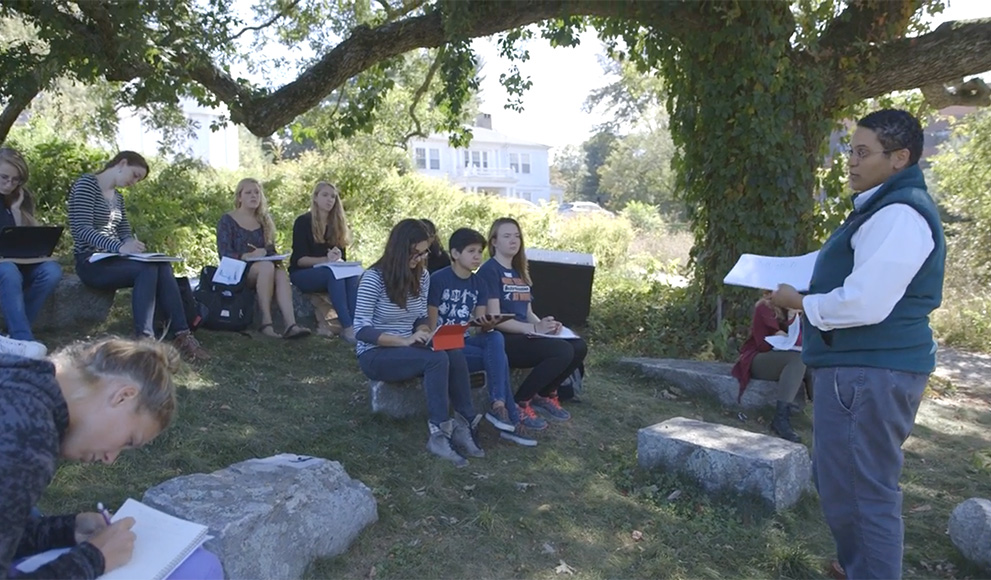Students in ES 300: Environmental Decisionmaking Compile a Comprehensive Greenhouse Gas Inventory for the College

As Wellesley prepares for the Ruhlman Conference tomorrow, the 12 students in Environmental Decisionmaking (ES 300), all of them seniors, are putting the final touches on their presentation about the greenhouse gas (GHG) inventory they have been compiling all semester in support of the College's Sustainability Plan. The inventory provides a detailed look at Wellesley's carbon footprint and suggests ways to reduce emissions.
"The course gives students the opportunity to work on a collaborative project that draws on everything they have learned in the major, as well as from the humanities, social sciences, and sciences, to think broadly about Wellesley's GHG emissions," said Monica Higgins, lecturer in environmental studies. "The hands-on experience students gain here is excellent preparation for the kind of work they will do in their careers."
This year's GHG project began during week one, when Higgins surprised the students by asking them to submit a resume and cover letter outlining their qualifications for one of several positions. The choices included project manager, Ruhlman presentation coordinator, data analyst, archivist, text editor, data editor, graphics editor, presentation manager, publication coordinator, sustainability committee liaison, and media liaison.
"The application process helps students see the project as a complex system and keeps them invested in the final outcome," said Higgins, who adopted the practice from Elizabeth R. DeSombre, Camilla Chandler Frost Professor of Environmental Studies. "It also provides an opportunity for students to do something they like. If you want a leadership role, you can have that. If not, you can choose something else."
Alyssa Brody '16, a political science and environmental studies double major, and the group's Ruhlman project coordinator said, "Having a distinct title has given us each a chance to practice stepping up and taking the lead on our respective topics, or alternatively, practice stepping back and letting others take the lead on theirs."
Once everyone had a job, the class began to identify the various sources of greenhouse gas at Wellesley. The students collected data to help them form a comprehensive picture of emissions in 2015 and in 1990, a standard baseline year for U.S. legislation and international treaties used to normalize reductions. Their goal was to see how Wellesley's emissions have changed over time, and how they compare with those of peer institutions such as Middlebury, Smith, MIT, Williams, and Olin.
"Data collection mostly consisted of a lot of long email threads, but some adventurous class members did make a trip to dig through file cabinets in the basement of the power plant in search of some power purchasing records from 1990," said Charlotte Benishek '16, an environmental studies major and the group’s data analyst.
Comparing Wellesley’s emissions with those of other institutions was more difficult, she said, "because each college conducts its audits slightly differently and includes slightly different things, so you often end up comparing apples to oranges."
After weeks of collecting data, the group shifted to analysis. They will present their findings in a detailed report to the College’s Sustainability Committee and post them online.
"As the project manager, I focused on making sure all of the separate pieces of the puzzle fit together and told a coherent, compelling story," said Julie Rong '16, an environmental studies major and economics minor. "With all of the data and methods in front of me, I was able to pose bigger-picture questions, such as: What are we missing? How can we best convey this information to our audience? What is the significance of this portion of the results? My goal was therefore to help create a product that would be both accessible to a broad audience and detailed enough to serve as a blueprint for behavioral change on campus."
The group worked collaboratively, discussing how best to convey the information—such as whether to use pie charts or graphs—and how much detail would be needed to explain their methodology and findings. One unexpected finding, the students said, was that Wellesley's use of electricity has not risen significantly since 1990, despite the huge increase in the use of electronic devices, primarily computers.
Throughout the inventory project, Higgins, whose background is in civil and environmental engineering, provided guidance and feedback. "I see myself as a manager who tries to bring out the best in her team members," she said. "I’d prefer we have a journey, and that the journey be good, rather than steering students toward a particular finding."
That approach is effective, she said, because the skills students learn from data collection and the synthesis of ideas can be applied to almost any kind of work, from community building to analyzing public health to writing about scientific issues.
Brody, the group's Ruhlman coordinator, agreed. "I think [Higgins' approach] allows students to organically pull upon knowledge and skills that they have gained over the past four years," she said. "We don’t walk into each class knowing, 'Oh, this is the class where the syllabus says I will use my knowledge of calculating greenhouse gas emissions,' Instead, we are actively problem solving and working toward our goals."
Brody continued, "You realize during this process how lessons learned all the way back in ES 101 can be applicable in this type of hands-on research. This class really requires you to think critically, problem solve, and find ways to connect what you’ve learned in past case studies and courses to a real-world issue."
